- Hawaii
- Big Island
- What to do in Hilo: seaside, waterfalls and lava tunnel

Rainy and green, Hilo is the most populated city on Big Island. A stronghold of sugar cane exploitation at the end of the 19th century, Hilo has become over the years a popular town with a colonial style whose architecture of the buildings still reminds us of its history.
The Hilo area also has many points of interest that are well worth a visit. Its very humid climate favors the presence of beautiful waterfalls and numerous lava flows have shaped the coastline, forming beautiful natural pools and ponds. It is even possible to visit an amazing lava tunnel near Hilo.
The Hilo area is interesting and diverse enough to justify at least one day on site to discover the city and its surroundings.
Summary
1Downtown Hilo
The city of Hilo has a special atmosphere. Quite different from other cities in Hawaii, the community of Hilo is predominantly Asian, a result of its past mainly focused on the sugar cane industry, providing work for many families from Asia.
Today the city has diversified and turned towards culture, omnipresent through the presence of small art galleries, or street art for example. It is pleasant to stroll along Kamehameha Avenue where many small shops have settled.

Hilo Farmers Market
Every day, the Farmers Market in Hilo honors small local producers or artisans who come to sell their products in a warm and relaxed atmosphere. The market is reputed to be the most authentic market in the entire archipelago and probably the best prices!
If you are passing by in the morning, don't hesitate to stop and admire the colorful stalls or buy some ripe fruit to please your palate!
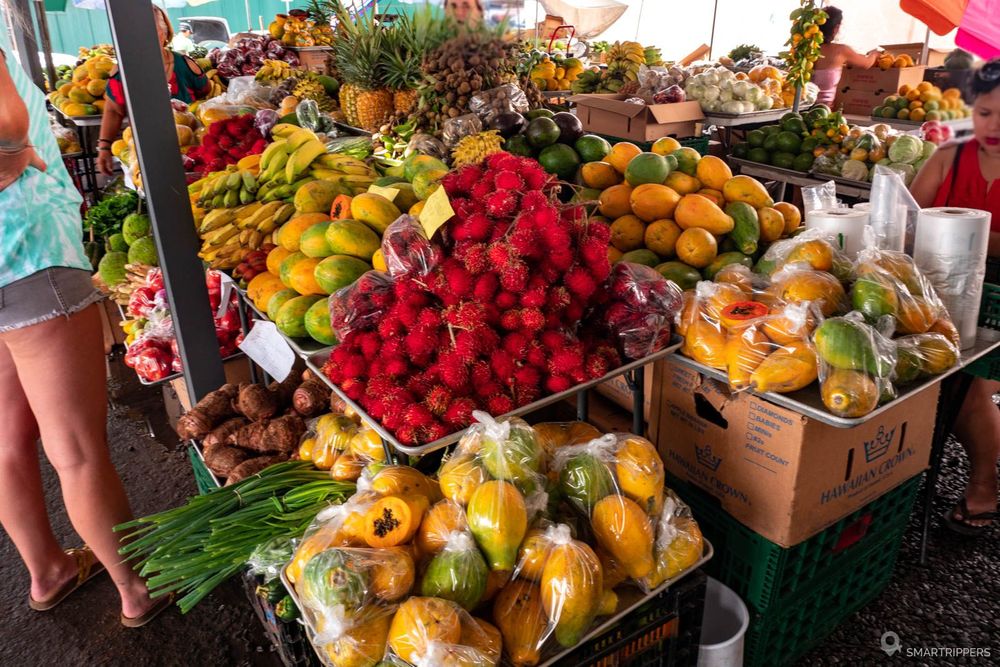

The market is open every day from 7:00 a.m. to 3:00 p.m. on Wednesdays and Saturdays, and from 8:00 a.m. to 3:00 p.m. on other days.
How to get to the Farmers Market in Hilo
The market takes place daily under a small covered esplanade at the corner of Kamehameha Avenue and Mamo Street. Numerous parking lots are available in the surrounding area, the largest being on Kamehameha Avenue, along with small tourist shops and restaurants.
Visit the Pacific Tsunami Museum
The city of Hilo claims to be the most tsunami-affected city in the world! We won't really be able to verify this, but what is certain is that the eastern coasts of Big Island are regularly hit by more or less deadly tsunamis.
The museum's main focus is on the history of Hilo's last two deadly tsunamis, the one on April 1, 1946, when a 14-meter wave hit the island, killing 160 people, and the one on May 22, 1960, which took the lives of 61 people.
The museum is open from Tuesday to Saturday from 10:00 am to 4:00 pm. It is closed on Sundays, Mondays and holidays. Admission is $8 per adult and $4 for children 6 to 17 years old.
How to access the Pacific Tsunami Museum
The museum is located at 130 Kamehameha Avenue. You can easily park in the large parking lot along Kamehameha Avenue just past the museum.
2Waterfalls near Hilo
Hilo is crossed by the Wailuku River, a wide river that flows into the ocean. Because the Hilo area is particularly wet due to its geographic location east of Mauna Kea, the rivers are lively and tumultuous.
This is why the Wailuku River offers many waterfalls more or less accessible and well known. Here are those that are the most easily accessible.
Rainbow Falls
Rainbow Falls are the most famous falls in Hilo. This beautiful, sometimes powerful and impressive waterfall is located on the Wailuku River. It rises from the top of its 24 meters before falling down in a beautiful turquoise water basin and in front of a small lava cave, which gives it a lot of charm.
If you are lucky enough to get there around 10am on a sunny morning, you may be able to see a beautiful rainbow with the sun reflected in the mist of the waterfall.
It is possible to reach on foot the upstream part of the waterfall where the river has carved many small natural pools. The access is through a staircase that goes up on the left and also allows to discover a wooded area with small Banyan Trees.
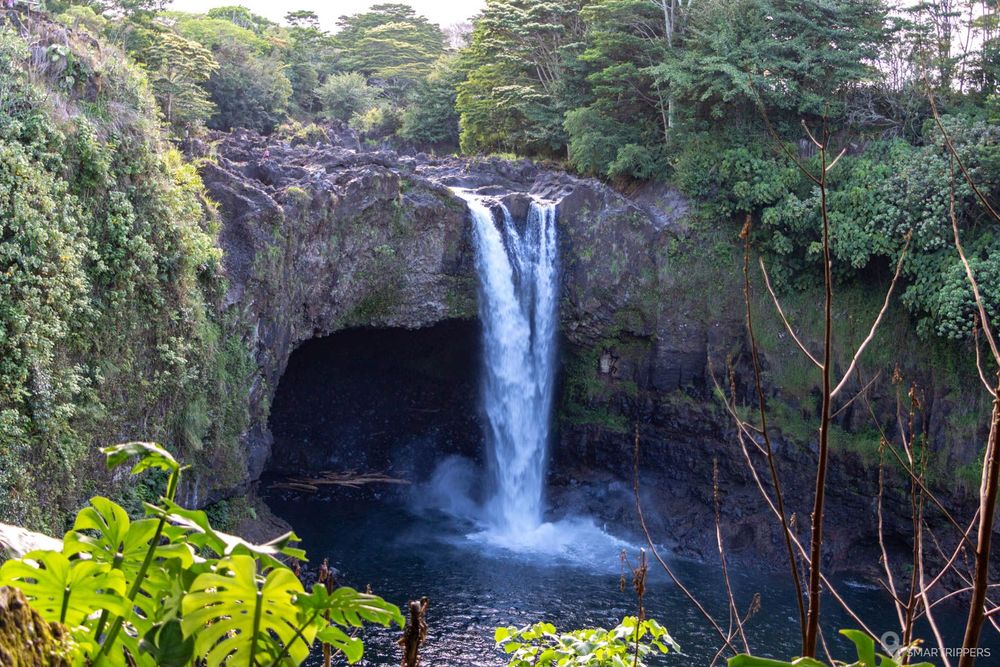

To observe the waterfall, a belvedere has been set up on the other side of the basin, allowing a beautiful view of the whole, surrounded by lush vegetation. Expect to find crowds here, especially on sunny mornings around 10am, as tourist buses come to drop off their passengers.
How to get to Rainbow Falls
Rainbow Falls are located within the Wailuku River State Park, which is free of charge. To get there, take Rainbow Drive to the parking lot near the waterfall.
Boiling Pots
This place refers to the natural basins shaped by the river below, which are connected by an underground water flow where the water seems to boil when the activity is intense (but which is in fact quite rare).
The lookout that has been built along the river also allows you to distinguish in the distance the Pe 'epe 'e Falls, a pretty waterfall whose appearance will vary depending on the last rains. It is a pity that the only viewpoint offers only a partial and distant view of the Pe 'epe 'e Falls in their green setting.

How to access Boiling Pots
Boiling Pots is located in the Wailuku River State Park which is free of charge. Access is at the end of Pe 'epe 'e Falls Road, a small street in a residential area. There is a parking lot at the end of the road with sanitary facilities. The area is not very busy.
3Beaches and Beach Parks around Hilo
The coast east of Hilo is dotted with small Beach Parks, all of which offer access to the ocean. Here the coastline has been sculpted by successive lava flows that have come to form small ponds and natural pools at the water's edge.
Keaukaha Beach Park
Located near the airport, this small beach park offers access to the ocean where some lava flows have formed small ponds. The interest remains however rather limited. The access is easy from Kalanianaole Avenue from where a small road leads to the parking lot. Sanitary facilities are available on site.


Onekahakaha Beach Park
Onekahakaha Beach Park provides access to an interesting area where lava has formed small natural pools that have been protected by a dyke to allow safe swimming and why not explore the seabed by snorkeling. The place is therefore ideal to come and splash around safely with young children, especially since the water is shallow and the swimming is lifeguarded.


The sandy beach being almost non-existent, you will put your towel on the grass lined with many trees. There are sanitary facilities with showers and numerous picnic tables.
How to get to Onekahaha Beach Park
Several parking lots are easily accessible at the end of Onekahaha Road. The protected swimming area is located on the far right, heading east.
Carl Smith Beach Park
This is our favorite part in the Hilo area! This beautiful little Beach Park is the perfect place to come for a swim. Here lava flows have shaped a jagged coastline that vegetation has covered, forming many small spots to get in the water.
Thanks to sandy bottoms, the color between blue and green is just an incentive to swim! And the turtles often come to the place which is rich in algae, the perfect opportunity to swim with them. We have seen several of them in the water.

The main swimming area is located on the right side of the park, behind the trees. It has the advantage of being protected from the waves thanks to old lava flows that form a small natural barrier and at the same time offer an interesting spot for snorkeling.
Several accesses allow to enter the water thanks to the stairs and ramps that have been installed to allow an easy entry. However, don't look for a beach here, you'll have to be content with putting your towel on the rocks or grass, unless you can access a tiny sand creek hidden below towards the middle of the park.



You will also find yourself in the shade of the trees thanks to a large and pleasant stretch of grass. The only drawback is the large number of families who come here on weekends.
We advise you to choose a day during the week to come and relax at Carl Smith Beach Park.
On site you will find sanitary facilities with showers and picnic tables. Swimming is lifeguarded.
How to get to Carl Smith Beach Park
Carl Smith Beach Park is located along Kalanianaole Avenue. Roadside parking is limited and it is not uncommon for the parking lot to be full. If this is the case, you can try to find a spot along Keaukaha Road which runs along the ocean and offers a few spaces.
Wai'olena Beach Park
This small Beach Park is home to small seawater ponds where it is possible to swim in a quiet area, the place being little frequented. You can also come and admire the sea here, strolling under the few palm trees that border the ocean. Showers and two covered picnic tables are available on site. Swimming is not lifeguarded.

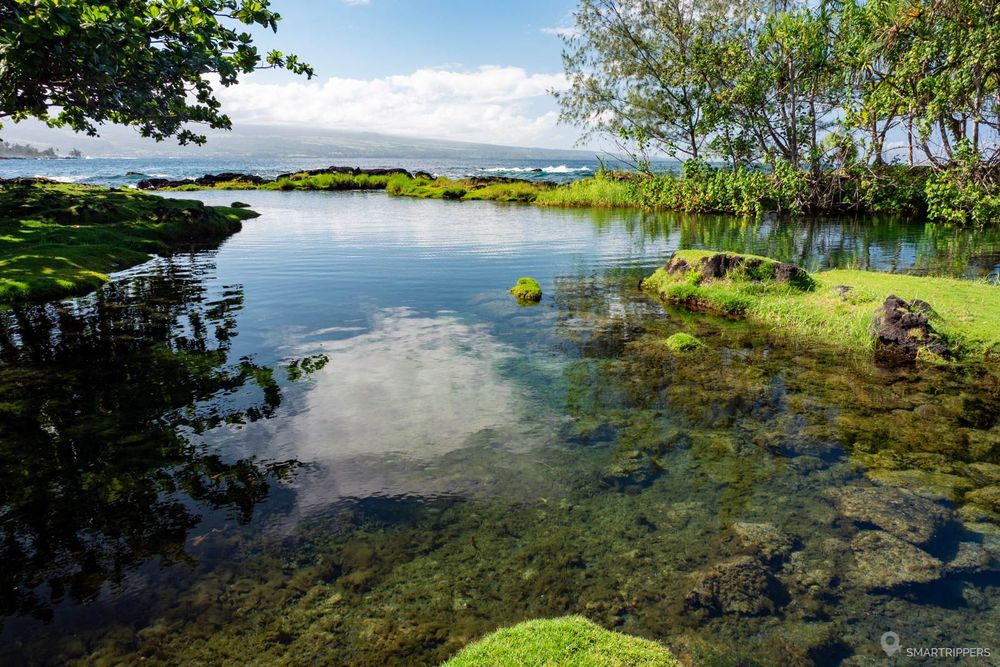
How to get to Wai'olena Beach Park
Access is very easy thanks to a small parking lot along Kalanianaole Avenue.
Wai'uli Beach Park
Just past Wai'olena Beach Park is Wai'uli Beach Park. There are also a few ponds but much less welcoming. Here again, the lava has shaped small natural pools where it is possible to swim but the access remains rather "wild".
However, if you are looking for a nice place to picnic, don't hesitate to stop here. The setting is very pleasant along the ocean with a few tables arranged under small wooden constructions.

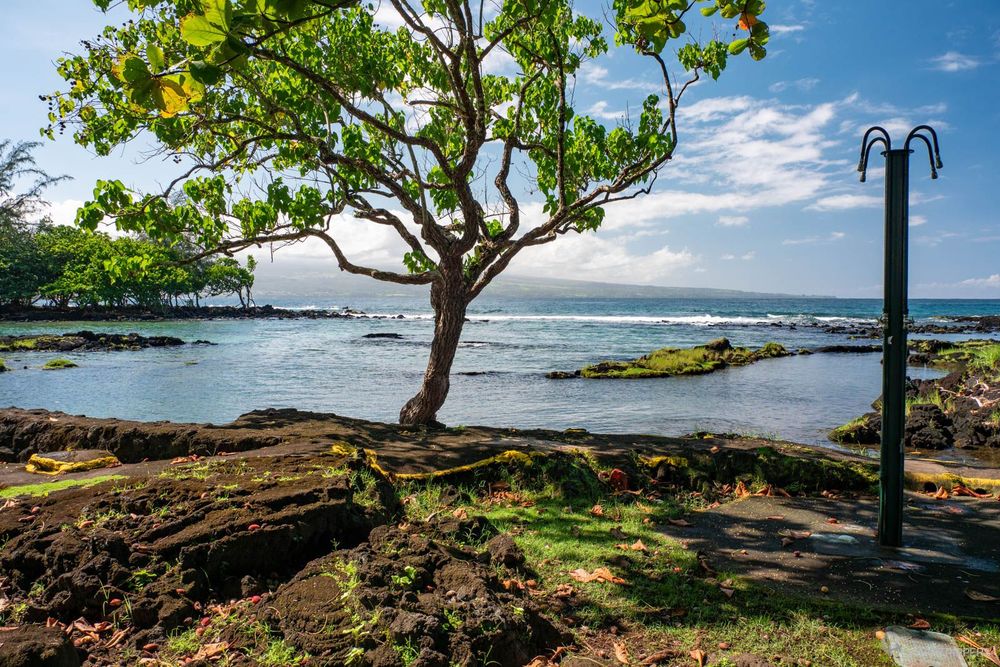
There are sanitary facilities and a shower on site. Swimming is not lifeguarded.
How to get to Wai'uli Beach Park
Access is very easy thanks to a small parking lot along Kalanianaole Avenue.
Richardson Ocean Park
This is one of the most popular places in Hilo, and it's easy to see why! As soon as we arrive, we are greeted by beautiful little ponds of water where the sky and the palm trees are reflected. It's beautiful!



The place lends itself particularly to relaxation near the small ponds. It is also possible to walk along the water's edge.
Moving to the right of the park, you will find a small black sand beach where swimming is lifeguarded. It is one of the few sandy beaches in Hilo. Although quite small, it allows you to enter the water quite easily, although you will need to bring water shoes as there are many rocks in the water.
The place is also famous for seeing turtles. It is also possible to walk a little on the rocks along the coast after having passed the beach.


On site there is a sanitary block with shower as well as some picnic tables.
How to get to Richardson Ocean Park
A large parking lot allows easy parking along Kalanianaole Avenue, but it is not uncommon for the parking lot to be full. In this case, it will be possible to use the Wai'uli Beach Park parking lot located only 200m westward.
Lehia Beach Park
This last park closes the list of Beach Park in Hilo. Here we find ourselves far from the crowd, quiet, face to face with the ocean. A peaceful place to watch the waves. It will be possible to come and swim at the edge in the rocks. There are no amenities on site. Swimming is not lifeguarded.

How to get to Lehia Beach Park
You will have to go to the very end of Kalanianaole Avenue to access the small dirt parking lot that serves the place.
4Exploring a lava tunnel
If you want to play the role of an apprentice speleologist, don't miss a visit to the Kaumana Caves, a unique place in Hawaii where you can easily explore an ancient lava tunnel.
Kaumana Caves
The Kaumana Caves are part of a vast complex of underground lava tunnels formed by the eruption of Mauna Loa in 1881. In total, nearly 40 km of galleries were formed by the lava that stopped only 2.5 km from Hilo that year!
Legend has it that the princess of the time, Ruth, came from Honolulu to pray to the Pele (Hawaiian volcano goddess) to stop the eruption in order to spare the city of Hilo as the lava approached at a great speed. Pele probably heard the prayers as the lava flow suddenly stopped, sparing the city and its inhabitants.
It is now possible to explore a small section of the lava tunnel as long as you are well equipped with a headlamp (mandatory, don't use your mobile phone, it would be really too dangerous), pants and good shoes.
The entrance to the Kaumana Caves is along the road. A long metal staircase leads to a collapse zone which offers the possibility to enter the tunnel. It is possible to explore the two tunnels, but the tunnel on the left is not very interesting because it is quickly clogged by collapses. The tunnel on the right, on the other hand, is very interesting and will allow you to progress for about 3 km, before reaching a private property. So you will have plenty to do!
Access to the tunnel is by walking on large blocks of lava, then you enter the cavity lined with wild vegetation, where long lianas hang. The first meters are quite luminous but very quickly the headlamp will be indispensable. At the end of several tens of meters, the darkness is total!

The progress through the tunnel is easy at first. There are different sequences of flows with different aspects that show that the lava has solidified in several stages. Then the progression will require some acrobatics to overcome obstacles and continue the exploration.

One thus passes from room to room, connected by small channels where one can sometimes only stand on knees and where it will be necessary to advance a few meters.
Sometimes you will notice tree roots seeping into the vault, hanging from the ceiling. A strange golden and silvery substance resembling crystals also lines the walls of the tunnel, making the exploration really fascinating. Finally, strangely enough, we will come across some ugly graffiti in the middle of the tunnel, which are quite old.

You will be able to continue the exploration as long as you wish, or until you reach the end of the public area (we have not gone that far). Few people come to explore the place, chances are you will be alone.
Remember to dress warmly because it is cool underground and humidity is very present, especially if it rains or has rained previously.
How to access the Kaumana Caves
Access is easy thanks to a small parking lot on Kaumana Drive. The place is indicated by a sign and there are a few picnic tables and sanitary facilities on site. Parking is on the other side of the road. Access to the stairs is behind the sign indicating Kaumana Caves.
We are Sandrine and Flo, French thirty-somethings. In 2019 we quit everything to live our dream, become nomads and travel around the world. We left with our baby, Lena, who was only 5 months old at the time. After a first trip around the Pacific Ocean by plane and a long 3 months stay in Hawaii, we left to discover Iceland for 3 months on board our 4WD pickup truck and truck camper. Then we continued our adventure in North America.
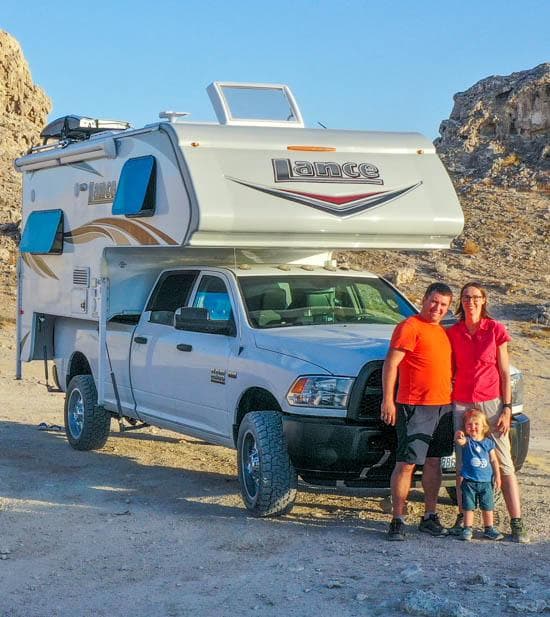
Today, if we can continue this adventure, it is above all thanks to our blog, Smartrippers! We created it one day in 2016, with the desire to share our good travel tips, without thinking that it would lead us there! We have developed it a lot over the years and have become experts on our 3 favorite destinations: Hawaii, Iceland and the American West. We now guide you to these destinations to help you plan the trip of your dreams!
Follow our adventures!